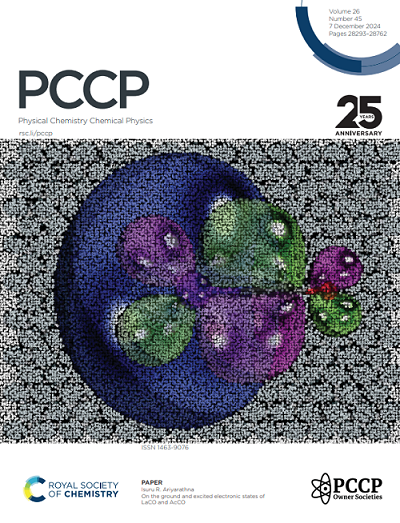聚环氧乙烷和树枝状纤维纳米二氧化硅复合电解质的自由体积结构与离子电导率的关系:利用正电子湮灭和宽带介电光谱的研究
IF 2.9
3区 化学
Q3 CHEMISTRY, PHYSICAL
引用次数: 0
摘要
负载聚环氧乙烷(PEO)的被动和主动填料,基于固态聚合物电解质(spe)被认为是目前锂金属电池中使用的可燃液体电解质的有前途的替代品。PEO基复合电解质离子电导率的提高是由于在相间区增加了离子传导途径。考虑到这一点,在本研究中,我们制备了树枝状纤维纳米二氧化硅(DFNS)负载PEO基聚合物复合材料(PEO- dnfs)和电解质(PEO-Li, PEO-Li-DFNS),其EO:Li = 20:1。选择DFNS作为填料是因为其独特的树枝状纤维结构,有望在复合材料中形成大的相间区。采用粉末x射线衍射(PXRD)、衰减全反射傅立叶变换红外光谱(ATR-FTIR)、差示扫描量热法(DSC)等技术对复合材料和电解质进行了表征,以确定化学键和热性能的变化。利用正电子湮没寿命谱(PALS)和宽带介电谱(BDS)分别对PEO的自由体积结构/链填充和离子传导机理进行了研究。由于链式填料的修改,相对自由体积随着DFNS的加载而增加。较高数量的自由体积空穴为离子扩散提供了额外的途径,从而导致离子电导率的增强。相对自由体积在离子电导率增强中的作用通过BDS观察到离子电导率与PEO电解质的节段弛豫之间的强耦合进一步得到证实。本文章由计算机程序翻译,如有差异,请以英文原文为准。
Correlations between free volume structure and ionic conductivity of poly (ethylene oxide) and dendritic fibrous nanosilica composite based electrolyte: An investigation using positron annihilation and broadband dielectric spectroscopy
Passive and active fillers loaded poly(ethylene oxide), PEO, based solid state polymer electrolytes (SPEs) are considered promising alternatives for currently used flammable liquid electrolytes in lithium metal batteries. The enhancement in ionic conductivity of PEO based composite electrolytes is attributed to the additional ion-conduction pathways available at the interphase region. Considering this aspect, in the present study, we have prepared dendritic fibrous nanosilica (DFNS) loaded PEO based polymer composite (PEO-DNFS) and electrolytes (PEO-Li, PEO-Li-DFNS) having (EO:Li = 20:1). DFNS has been chosen as filler due to its unique dendritic fibrous structure which is expected to create large interphase region in the composites. These composites and electrolytes were characterized using various techniques viz. powder X-ray diffraction (PXRD), attenuated total reflectance Fourier transform infrared spectroscopy (ATR-FTIR), differential scanning calorimetry (DSC) for determining the modifications in chemical bonding and thermal properties. Positron annihilation lifetime spectroscopy (PALS) and broadband dielectric spectroscopy (BDS) were employed to determine the modifications in the free volume structure/chain packing of PEO and ion conduction mechanism, respectively. The relative free volume was observed to increase with DFNS loading due to modifications in the chain packing. The higher number of free volume holes provide additional pathways for ionic diffusion leading to an enhancement in ionic conductivity. The role of relative free volume in ionic conductivity enhancement is further established through the strong coupling observed between ionic conduction and segmental relaxations of PEO electrolytes investigated using BDS.
求助全文
通过发布文献求助,成功后即可免费获取论文全文。
去求助
来源期刊

Physical Chemistry Chemical Physics
化学-物理:原子、分子和化学物理
CiteScore
5.50
自引率
9.10%
发文量
2675
审稿时长
2.0 months
期刊介绍:
Physical Chemistry Chemical Physics (PCCP) is an international journal co-owned by 19 physical chemistry and physics societies from around the world. This journal publishes original, cutting-edge research in physical chemistry, chemical physics and biophysical chemistry. To be suitable for publication in PCCP, articles must include significant innovation and/or insight into physical chemistry; this is the most important criterion that reviewers and Editors will judge against when evaluating submissions.
The journal has a broad scope and welcomes contributions spanning experiment, theory, computation and data science. Topical coverage includes spectroscopy, dynamics, kinetics, statistical mechanics, thermodynamics, electrochemistry, catalysis, surface science, quantum mechanics, quantum computing and machine learning. Interdisciplinary research areas such as polymers and soft matter, materials, nanoscience, energy, surfaces/interfaces, and biophysical chemistry are welcomed if they demonstrate significant innovation and/or insight into physical chemistry. Joined experimental/theoretical studies are particularly appreciated when complementary and based on up-to-date approaches.
 求助内容:
求助内容: 应助结果提醒方式:
应助结果提醒方式:


